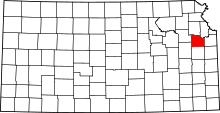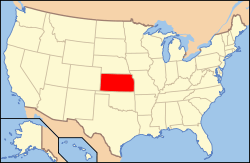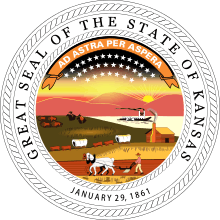Douglas County, Kansas
| Douglas County, Kansas | |
|---|---|
| County | |
 Douglas County Courthouse in Lawrence | |
 Location in the U.S. state of Kansas | |
 Kansas's location in the U.S. | |
| Founded | August 25, 1855 |
| Named for | Stephen Douglas |
| Seat | Lawrence |
| Largest city | Lawrence |
| Area | |
| • Total | 475 sq mi (1,230 km2) |
| • Land | 456 sq mi (1,181 km2) |
| • Water | 19 sq mi (49 km2), 4.0% |
| Population (est.) | |
| • (2015) | 118,053 |
| • Density | 243/sq mi (94/km²) |
| Congressional district | 2nd |
| Time zone | Central: UTC-6/-5 |
| Website |
douglascountyks |
Coordinates: 38°52′N 95°14′W / 38.867°N 95.233°W
Douglas County (county code DG) is a county located in the U.S. state of Kansas. As of the 2010 census, the county population was 110,826,[1] making it the fifth-most populous county in Kansas. Its county seat and most populous city is Lawrence.[2]
History
Early history
For many millennia, the Great Plains of North America was inhabited by nomadic Native Americans. From the 16th century to 18th century, the Kingdom of France claimed ownership of large parts of North America. In 1762, after the French and Indian War, France secretly ceded New France to Spain, per the Treaty of Fontainebleau.
19th century
In 1802, Spain returned most of the land to France, but keeping title to about 7,500 square miles. In 1803, most of the land for modern day Kansas was acquired by the United States from France as part of the 828,000 square mile Louisiana Purchase for 2.83 cents per acre.
In 1854, the Kansas Territory was organized, then in 1861 Kansas became the 34th U.S. state. In 1855, Douglas County was established. Douglas County was opened for settlement on May 15, 1854, and was named for Stephen A. Douglas,[3] a senator from Illinois. The county was practically at the center of the Bleeding Kansas years as leaders in Lecompton, the territorial capital, wanted Kansas to be a slave state and leaders in Lawrence wanted Kansas to be a free state. Because of this, multiple events took place, including the drafting of the Lecompton Constitution admitting Kansas as a slave state, the sacking of Lawrence, and the Battle of Black Jack.
The first railroad in Douglas County, the Union Pacific, was built through that territory in 1864.[4]
Geography
According to the U.S. Census Bureau, the county has a total area of 475 square miles (1,230 km2), of which 456 square miles (1,180 km2) is land and 19 square miles (49 km2) (4.0%) is water.[5] It is the fifth-smallest county in Kansas by land area. Much of its northern boundary is defined by the Kansas River, which flows through Lawrence and provides hydropower at the Bowersock Dam.
Adjacent counties
- Jefferson County (north)
- Leavenworth County (northeast)
- Johnson County (east)
- Miami County (southeast)
- Franklin County (south)
- Osage County (southwest)
- Shawnee County (northwest)
Demographics
| Historical population | |||
|---|---|---|---|
| Census | Pop. | %± | |
| 1860 | 8,637 | — | |
| 1870 | 20,592 | 138.4% | |
| 1880 | 21,700 | 5.4% | |
| 1890 | 23,961 | 10.4% | |
| 1900 | 25,096 | 4.7% | |
| 1910 | 24,724 | −1.5% | |
| 1920 | 23,998 | −2.9% | |
| 1930 | 25,143 | 4.8% | |
| 1940 | 25,171 | 0.1% | |
| 1950 | 34,086 | 35.4% | |
| 1960 | 43,720 | 28.3% | |
| 1970 | 57,932 | 32.5% | |
| 1980 | 67,640 | 16.8% | |
| 1990 | 81,798 | 20.9% | |
| 2000 | 99,962 | 22.2% | |
| 2010 | 110,826 | 10.9% | |
| Est. 2015 | 118,053 | [6] | 6.5% |
| U.S. Decennial Census[7] 1790-1960[8] 1900-1990[9] 1990-2000[10] 2010-2014[1] | |||
Douglas County comprises the Lawrence, KS Metropolitan Statistical Area, which is also included in the Kansas City-Overland Park-Kansas City, MO-KS Combined Statistical Area.
As of the 2000 census,[11] there were 99,962 people, 38,486 households, and 21,167 families residing in the county. The population density was 219 people per square mile (84/km²). There were 40,250 housing units at an average density of 88 per square mile (34/km²). The racial makeup of the county was 86.1% White, 4.2% Black or African American, 2.6% Native American, 3.1% Asian, 0.1% Pacific Islander, 1.2% from other races, and 2.7% from two or more races. Hispanic or Latino of any race were 3.3% of the population.
There were 38,486 households out of which 27.4% had children under the age of 18 living with them, 43.1% were married couples living together, 8.5% had a female householder with no husband present, and 45.0% were non-families. 28.5% of all households were made up of individuals and 5.8% had someone living alone who was 65 years of age or older. The average household size was 2.37 and the average family size was 2.97.
In the county the population was spread out with 20.4% under the age of 18, 26.4% from 18 to 24, 28.3% from 25 to 44, 16.9% from 45 to 64, and 7.9% who were 65 years of age or older. The median age was 27 years. For every 100 females there were 98.70 males. For every 100 females age 18 and over, there were 97.70 males.
The median income for a household in the county was $37,547, and the median income for a family was $53,991. Males had a median income of $35,577 versus $27,225 for females. The per capita income for the county was $19,952. About 6.2% of families and 15.9% of the population were below the poverty line, including 9.0% of those under age 18 and 7.3% of those age 65 or over.
Government
Douglas County is currently served by county commissioners Mike Gaughan, Nancy Thellman, and Jim Flory.[12]
Democratic state representatives of the county include John Wilson (10th District), Barbara Ballard (44th District), and Dennis Highberger (46th District); Republican state representatives include Connie O'Brien (42nd District), Tom Sloan (45th District) and Ken Corbet (54th District). The three state senators representing the county, Marci Francisco (2nd District), Tom Holland (3rd District), and Anthony Hensley (19th District), are all Democrats.[13]
Transportation

Major highways
- Interstate 70, as part of the Kansas Turnpike, runs east to west just north of Lawrence.
- U.S. Highway 59 runs north to south through the middle of the county and the middle of Lawrence.
- U.S. Highway 40 virtually follows the Oregon Trail heading west out of Lawrence.
- U.S. Highway 56 runs east to west in the southern half of the county, going through Baldwin City and skirts the Santa Fe Trail.
- K-10 runs from the I-70 Lecompton Exchange along the south and west border of Lawrence to US-59 then north until 23rd Street where it heads east out of town into Johnson County.
- Other major highways include: US-24 which is in Grant township leading from Leavenworth to Jefferson County; K-32 starts just outside Lawrence and leads into Leavenworth County and K-33 is in extreme southeast Douglas County and leads into Franklin County.
County Highways
Douglas County also maintains an extensive network of county highways to serve the rural areas of the county. None of these county highways is in the Lawrence city limits.
Education

Unified school districts
Douglas County is served by seven school districts.
- Lawrence USD 497 serves Lawrence and the Clinton Lake area.
- Baldwin City USD 348 serves Baldwin City and most of southern Douglas County.
- Perry-Lecompton USD 343 serves Lecompton and most of northwest Douglas County.
- Eudora USD 491 serves Eudora and the northeast part of the county.
- Santa Fe Trail USD 434 covers the southwest part of the county.
- Wellsville USD 289 covers extreme southeast Douglas County.
- Shawnee Heights USD 450 services the extreme western part of the county including Big Springs.
Universities and colleges
The University of Kansas's main campus is located in Lawrence as is Haskell Indian Nations University. Baker University, the state's oldest university, is located in Baldwin City.
Parks
Clinton Lake, completed in 1980, offers boating, fishing and other water sports and various parks surrounding the lake provides camping and trails for mountain biking, hiking and horseback riding.[14]
Lone Star Lake is a small country lake to the southwest of Lawrence offers fishing, boating and camping. Just northwest of Baldwin City is Douglas State Fishing Lake which provides hunting, fishing and limited camping. Other parks around the county include Black Jack Park which includes the Ivan Boyd Prairie Preserve and Robert Hall Pearson Memorial Park, Broken Arrow Park in Lawrence and Wells Overlook Park just south of Lawrence.[15]
Events
Major events in the county include the Maple Leaf Festival in Baldwin City every third full weekend in October.[16] Lecompton's Territorial Days take place every year in June[17] and Lawrence has many parades throughout the year including Christmas and St. Patrick's Day.[18][19]
Communities
Incorporated cities
Unincorporated communities
Townships
Douglas County is divided into nine townships. The city of Lawrence is considered governmentally independent and is excluded from the census figures for the townships. In the following table, the population center is the largest city (or cities) of significant size included in that township's population total.
| Township | FIPS | Population center |
Population | Population density /km² (/sq mi) |
Land area km² (sq mi) | Water area km² (sq mi) | Water % | Geographic coordinates |
|---|---|---|---|---|---|---|---|---|
| Clinton | 14325 | 531 | 7 (17) | 80 (31) | 26 (10) | 24.41% | 38°54′18″N 95°24′20″W / 38.90500°N 95.40556°W | |
| Eudora | 21700 | Eudora | 5,571 | 43 (113) | 128 (49) | 2 (1) | 1.57% | 38°55′42″N 95°6′15″W / 38.92833°N 95.10417°W |
| Grant | 27650 | 442 | 10 (27) | 43 (16) | 0 (0) | 0.74% | 39°0′8″N 95°13′19″W / 39.00222°N 95.22194°W | |
| Kanwaka | 36075 | 1,317 | 12 (30) | 114 (44) | 8 (3) | 6.69% | 38°57′37″N 95°23′16″W / 38.96028°N 95.38778°W | |
| Lecompton | 39175 | Lecompton | 1,761 | 20 (51) | 90 (35) | 2 (1) | 2.45% | 39°2′31″N 95°24′27″W / 39.04194°N 95.40750°W |
| Marion | 44700 | 836 | 5 (12) | 185 (72) | 1 (0) | 0.52% | 38°49′4″N 95°24′35″W / 38.81778°N 95.40972°W | |
| Palmyra | 54225 | Baldwin City | 5,760 | 27 (70) | 212 (82) | 2 (1) | 0.79% | 38°47′0″N 95°10′40″W / 38.78333°N 95.17778°W |
| Wakarusa | 74400 | 2,237 | 19 (49) | 119 (46) | 2 (1) | 1.81% | 38°55′49″N 95°14′43″W / 38.93028°N 95.24528°W | |
| Willow Springs | 79500 | 1,409 | 10 (26) | 141 (54) | 1 (0) | 0.54% | 38°47′23″N 95°18′17″W / 38.78972°N 95.30472°W | |
| Sources: "Census 2000 U.S. Gazetteer Files". U.S. Census Bureau, Geography Division. | ||||||||
Historic Townships

The county originally had only four townships. Lecompton comprised the area of Lecompton, Kanwaka, and Clinton townships; Washington took the place of Marion and Willow Springs townships; Wakarusa comprised both Wakarusa and Eudora townships; and Calhoun was the original name of Palmyra township. Grant township was annexed from Jefferson County in 1874.
Notable people
- Isaac F. Hughes, Douglas County commissioner and City Council member in both Lawrence, Kansas, and Los Angeles, California.
See also
- National Register of Historic Places listings in Douglas County, Kansas
- Kansas River - Natural crossing point for westward wagon trains on the Oregon Trail
- California Road - Cutoff on the Oregon Trail to Lawrence, Kansas from Westport
- Santa Fe Trail Swales - Visible near Black Jack Park
- Geographic Information System Viewers
|
|
References
- 1 2 "State & County QuickFacts". United States Census Bureau. Retrieved June 16, 2015.
- ↑ "Find a County". National Association of Counties. Retrieved 2011-06-07.
- ↑ Gannett, Henry (1905). The Origin of Certain Place Names in the United States. Govt. Print. Off. p. 108.
- ↑ Blackmar, Frank Wilson (1912). Kansas: A Cyclopedia of State History, Embracing Events, Institutions, Industries, Counties, Cities, Towns, Prominent Persons, Etc. Standard Publishing Company. p. 539.
- ↑ "US Gazetteer files: 2010, 2000, and 1990". United States Census Bureau. 2011-02-12. Retrieved 2011-04-23.
- ↑ "County Totals Dataset: Population, Population Change and Estimated Components of Population Change: April 1, 2010 to July 1, 2015". Retrieved July 2, 2016.
- ↑ "U.S. Decennial Census". United States Census Bureau. Retrieved July 24, 2014.
- ↑ "Historical Census Browser". University of Virginia Library. Retrieved July 24, 2014.
- ↑ "Population of Counties by Decennial Census: 1900 to 1990". United States Census Bureau. Retrieved July 24, 2014.
- ↑ "Census 2000 PHC-T-4. Ranking Tables for Counties: 1990 and 2000" (PDF). United States Census Bureau. Retrieved July 24, 2014.
- ↑ "American FactFinder". United States Census Bureau. Retrieved 2008-01-31.
- ↑ Douglas County - Board of Commissioners
- ↑ Douglas County - State Officials
- ↑ http://www.nwk.usace.army.mil/CL/
- ↑ http://douglas-county.org/depts/pw/pw_countyparks.aspx?category_id=
- ↑ http://baldwincity.org/community/mapleleaf/
- ↑ http://www.lecomptonterritorialdays.com/
- ↑ http://lawrencestpatricksdayparade.com/
- ↑ http://www.lawrencechristmasparade.org/
Further reading
- County
- Armitage, Katie H., “‘Seeking a Home Where He Himself Is Free’: African Americans Build a Community in Douglas County, Kansas,” Kansas History, 31 (Autumn 2008), 154–75
- Nowak, David. J. Assessing Urban Forest Effects and Values, Douglas County, Kansas. Newtown Square, PA: United States Forest Service, Northern Research Station, 2014.
- State
- History of the State of Kansas; William G. Cutler; A.T. Andreas Publisher; 1883. (Online HTML eBook)
- Kansas : A Cyclopedia of State History, Embracing Events, Institutions, Industries, Counties, Cities, Towns, Prominent Persons, Etc; 3 Volumes; Frank W. Blackmar; Standard Publishing Co; 944 / 955 / 824 pages; 1912. (Volume1 - Download 54MB PDF eBook), (Volume2 - Download 53MB PDF eBook), (Volume3 - Download 33MB PDF eBook)
External links
| Wikimedia Commons has media related to Douglas County, Kansas. |
- County
- Douglas County - Official
- Douglas County - Directory of Public Officials
- Douglas County - Law Library
- Other
- Aerial Photography from Multiple Decades
- Daily World, Google news archive. —PDFs for 1,062 issues, dating from 1892 through 1895.
- Daily Record, Google news archive. —PDFs for 998 issues, dating from 1889 through 1893.
- Maps
- Douglas County Maps: Current, Historic, KDOT
- Kansas Highway Maps: Current, Historic, KDOT
- Kansas Railroad Maps: Current, 1996, 1915, KDOT and Kansas Historical Society
 |
Shawnee County | Jefferson County | Leavenworth County |  |
| |
Johnson County | |||
| ||||
| | ||||
| Osage County | Franklin County | Miami County |


